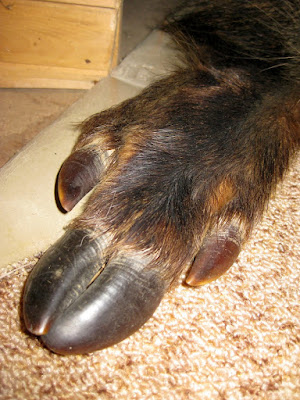In order to produce a good wine, the must needs to have an appropriate quantity of sugar; this gets converted to alcohol during the fermentation process. If the natural grape sugars are not enough, sugar needs to be added. (To explain more what this means, I plan a subsequent post about the Hydrometer!)
In the case of the white grapes, the sugar level was a little over 18 degrees, whereas the desirable level is in the region 20 to 21 degrees. With the red grapes (which apart from being a different variety of course, sat two weeks longer in the sun before picking), the sugar level was a little under 20 degrees which is good but should be a bit higher. So in both cases some sugar needs to be added.
A rough estimate of the quantity of white must was 500 litres. And about 150 litres of red.
The magic formula (so I'm told) is that 1kg of sugar will increase the sugar level of 100 litres by 0.7 degrees.
The white must should be raised around 2 degrees to bring it close to 21. So let's the desired increase is 2.1 degrees (3 times 0.7). And it's 500 litres (5 x 100 litres). So 15 kg (3 x 5) of sugar was added.
With the red, I was told 4kg of sugar should be added. So 150 litres will have it's sugar level raised by about 2.6 degrees, with an end result around 22 degrees. I was told this would make a semi-sweet red. Now my personal preference is for dry reds, but this year is for learning so I don't want to interfere until I know what I'm talking about!
Wednesday, September 30, 2009
Monday, September 28, 2009
The red grapes are in...
At the weekend we picked the red grapes. Unlike the the white grapes, which can be pressed immediately, the red grapes need to sit for a week before pressing. If they were pressed immediately a Rosé wine would be the result. We will return during the coming weekend to do the pressing.
Last time around we had a Scottish family living in Siófok helping out; this time the immigrant workers came from Ireland and Spain: my brother Gary and his partner Marta.
Child labour again too:
The crushed grapes look lovely:
The sugar level came to almost 20 degrees which meant that only a little sugar needed to be added to the 'must' to bring it up to the desired 21 degrees level.
Compare the colour of the red grape juice with that of the white two weeks ago!
Learning from the lesson of the white grapes, we took away lots of red grape juice to drink (about 15 litres) - perhaps a little too much because we have a lot less red than white and probably not enough to fill a barrel!
Off to drink some more now before it starts fermenting. A few more pictures here.
Last time around we had a Scottish family living in Siófok helping out; this time the immigrant workers came from Ireland and Spain: my brother Gary and his partner Marta.
Child labour again too:
The crushed grapes look lovely:
The sugar level came to almost 20 degrees which meant that only a little sugar needed to be added to the 'must' to bring it up to the desired 21 degrees level.
Compare the colour of the red grape juice with that of the white two weeks ago!
Learning from the lesson of the white grapes, we took away lots of red grape juice to drink (about 15 litres) - perhaps a little too much because we have a lot less red than white and probably not enough to fill a barrel!
Off to drink some more now before it starts fermenting. A few more pictures here.
Friday, September 18, 2009
Must (grape juice)
The grape juice, "Must" in both Hungarian and English, is really really tasty! We should have bottled more of it, but didn't have enough plastic bottles. Anyway, one must drink it within a few days before it starts to ferment.
I saw it selling in a cafe on the Ráday utca this week for 200Ft (60 euro cents) per deciliter.

I saw it selling in a cafe on the Ráday utca this week for 200Ft (60 euro cents) per deciliter.
The juice in the above picture was taken directly from the bath when the grapes were crushed by the mill, so it is quite cloudy.
The picture below shows the same jug, later on, after the remaining juice had settled. You can see how much sediment it contains.
The juice that came from the pressed grapes is a bit clearer, but still contains a lot of sediment which will be 'racked off' from the barrels in due course.
Thursday, September 17, 2009
Pressing the grapes
After the grapes are picked they first go into the daráló (mill) which removes the stalks and squeezes them a bit.
The bath fills up with the yummy grapes...
Some of the juice runs out of the bath - either directly into the barrel ...
or into a bucket which is poured into the barrel...
Next the grapes are lifted from the bath into the press...
the top is put on the press...
the screw is turned ...
and the juice - called "must" in Hungarian - flows out into buckets, and it is poured into the barrels using a funnel.
Once no more juice can be obtained, the press is partially dismantled, the pulp is removed and dumped unceremoniously onto a tarpaulin on the ground.
After all the grapes have been taken from the bath and pressed, the collected pulp is scooped up and returned to the bath. It will sit there for about 3 days, after which it will be pressed again - a lot more juice comes out and this "second pressing" is better quality.
This is how the grapes look after the first pressing, they are far from being dried out:

The pressed juice turned out to have a sugar level of about 18 degrees. That's reasonably good but since the sugar level determines the alcohol level in the end, it will need sugar added to bring it up to 20-21 degrees. I'll write about this in a follow-up post.
The bath fills up with the yummy grapes...
Some of the juice runs out of the bath - either directly into the barrel ...
or into a bucket which is poured into the barrel...
Next the grapes are lifted from the bath into the press...
the top is put on the press...
the screw is turned ...
and the juice - called "must" in Hungarian - flows out into buckets, and it is poured into the barrels using a funnel.
Once no more juice can be obtained, the press is partially dismantled, the pulp is removed and dumped unceremoniously onto a tarpaulin on the ground.
After all the grapes have been taken from the bath and pressed, the collected pulp is scooped up and returned to the bath. It will sit there for about 3 days, after which it will be pressed again - a lot more juice comes out and this "second pressing" is better quality.
This is how the grapes look after the first pressing, they are far from being dried out:
The pressed juice turned out to have a sugar level of about 18 degrees. That's reasonably good but since the sugar level determines the alcohol level in the end, it will need sugar added to bring it up to 20-21 degrees. I'll write about this in a follow-up post.
Wednesday, September 16, 2009
Szüret (Harvest)
We harvested the white grapes at the weekend. The red ones will be picked 2 weeks later.
The next post will describe the first steps in making the wine!
We had lots of help. Child labour too!
Afterwards there was Gulyásleves (Gulash soup) for lunch, made by Györgyi's mother:
Comely maidens helped press the grapes the old fashioned way...
And everyone went home with some juice and some grapes:
The next post will describe the first steps in making the wine!
Friday, September 4, 2009
Wednesday, September 2, 2009
Vine types
We have a number of different types of vine. I don't think anybody knows exactly what they all are. They just get mixed together when the wine is made.
This one is probably Cirfandli (Zierfandler) - not the same as Zinfandel!
This one is probably Kékoportó (Blauer Portugieser):
This one (what's left of it!) is called Kövérszőlő which means fat grape and is nicest for eating:
This one is probably Cirfandli (Zierfandler) - not the same as Zinfandel!
This one is probably Kékoportó (Blauer Portugieser):
This one (what's left of it!) is called Kövérszőlő which means fat grape and is nicest for eating:
Tuesday, September 1, 2009
Old coins
While cleaning out the house we found a bunch of old coins - mainly "filler" from the late 80s. There were 100 fillers to a forint. Occasionally utility bills still show fractions of a forint; I haven't seen it used anywhere else. Fillers were taken out of circulation in 1999; even 1 and 2 forint coins were withdrawn last year. The silver ones are made from aluminium and don't sound or feel like real coins!
The current exchange rate is about 270 forint to the Euro. It means a 10 filler coin, if still valid, would have a whopping value of 37/1000 Eurocent, or 37/100000 Euro.
We also found a coin dated 1881. In very poor condition, it appears to be a 1 krajczár coin (called "Kreuzer" in Austria). Originally there were 60 of these to a Forint (known as "Gulden" in Austria); by the time this coin was issued it had been decimalized.
All of these are worth buttons!
We also found some old baking ingredients with "use by" dates up to 10 years ago!
The current exchange rate is about 270 forint to the Euro. It means a 10 filler coin, if still valid, would have a whopping value of 37/1000 Eurocent, or 37/100000 Euro.
We also found a coin dated 1881. In very poor condition, it appears to be a 1 krajczár coin (called "Kreuzer" in Austria). Originally there were 60 of these to a Forint (known as "Gulden" in Austria); by the time this coin was issued it had been decimalized.
All of these are worth buttons!
We also found some old baking ingredients with "use by" dates up to 10 years ago!
Subscribe to:
Comments (Atom)











